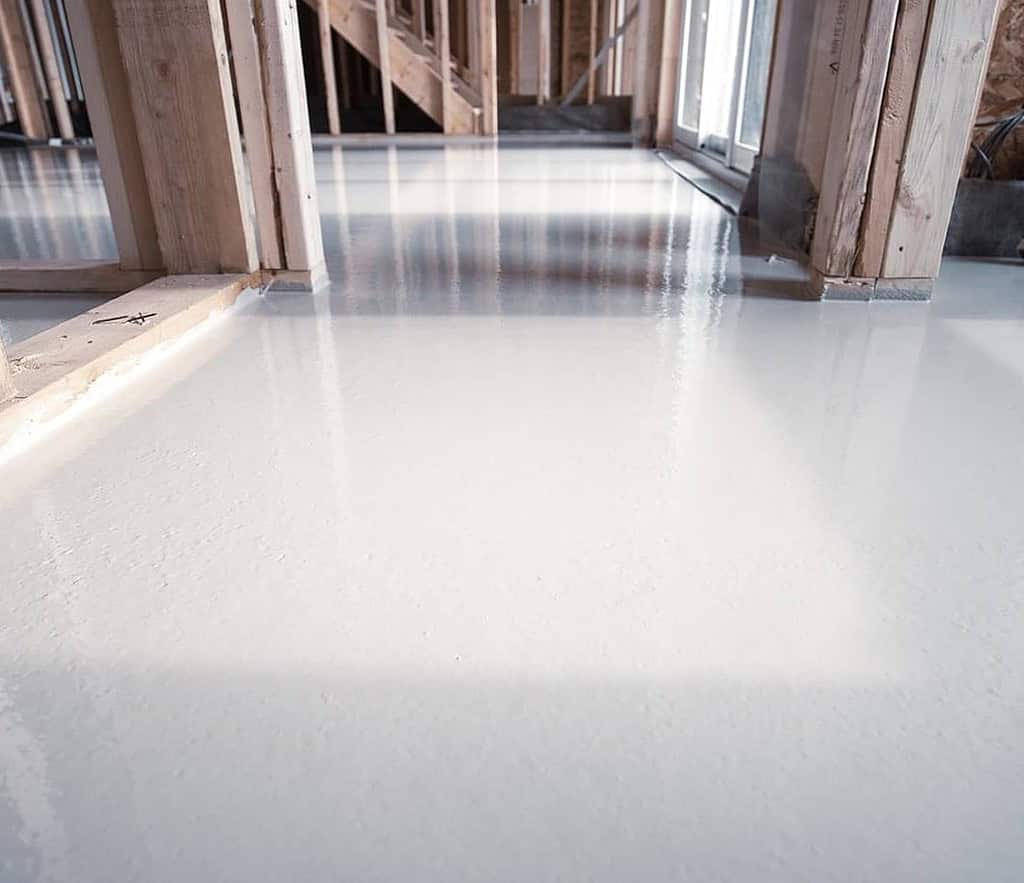The self-leveling floor is an easy way to build a beautiful concrete floor. But then, it’s time to start building your dream space! Get ready to enjoy the benefits of self-leveling concrete floors!
When do you need self-leveling concrete? Most people search for how to level their concrete in the office or basement. Also, they are looking to find a concrete leveling solution for their business space. Another critical question for all newbies is how to choose the best material. Let’s go deeper into the details.
What is Self-leveling Floor?
The self-leveling floor is a cementitious compound designed to flow, fill low spots, and create a flat and smooth surface. Also, it is often used as a subsurface for other resilient flooring products.

In short, the consistency of a self-leveler is more of a slurry. That’s why you can’t use it on vertical surfaces. Instead, a floor leveler is commonly used on interior floors. Typical applications include warehouse floors, institutional, educational, and commercial.
Indeed, most residential owners can do small DIY jobs by pouring a few bags on the floor without hiring a pro. But when you get a more complex project or more extensive area, we recommend using contractors with experience.
Using automatic pumping services for a self-leveler pour could be a great idea. Besides, most pros are ready to pour significant volumes; we have compact mixing pumps. Also, using a pump and applying pre-blended cementitious compounds makes it so easy to do a quality job.
Moreover, compared to concrete, floor leveling underlayments are relatively thin. And it’s hard to guarantee the final result without proper equipment.
Also, good to know that levelers are not the best options for heavy-duty manufacturing and industrial environments. Therefore, dragging heavy equipment or loaded pallets can gouge or damage the surface.
When using a Self-Leveling floor?
An installer can use self-leveling cement before the installation of ceramic tile. Also, to increase floor height to meet architectural specifications from 0” – 4”. In this case, you can forget hand-mixing bag after bag of self-leveling underlayment in buckets. However, for that thickness, you will need to use automatic equipment.
Either way, for engineered wood, laminate, or epoxy moisture barrier floorings. Leveling is a way to achieve a subfloor with minimal height variations and higher compressive strength.
Given these points, our specialists install floor-leveling compounds with concrete pumps. The modern one can mix, control the amount of water, and pump pre-blended cementitious materials. Also, similar methods are valid for Radiant Heating Flooring and laminate underlayment applications.
As shown above, large jobs are no longer a problem, and the days of hauling pallets of bags all over a job site are over. Usually, we can set up an entire mix station outside and pump the mixed self-leveling compound to wherever it’s needed. Because the results are more consistent, and the time savings are enormous.
Self-leveling Cement Overlay
Another great option for leveling is a cement overlay. The self-leveling floor is easy to maintain and could be a beautiful high-gloss finish. Polished concrete overlays are decorative floors world’s superstars, especially in high-profile retail and commercial spaces.
However, most existing concrete slabs can be polished and require no expensive work. Conversely, some have significant flaws, such as spalled areas, carpet tack holes, and extensive patchwork, which would still show through after polishing.

Most projects require overlay topping; our products include Ardex PC-T and Rapid Set TRU PC. This polished concrete topping is white, gray, and light gray. Also, this 6,800 psi material is scratch-, indent-resistant, and polishable in 24 hours. It also contains a specialty aggregate to replicate the appearance of standard polished concrete better.
Since it’s like concrete, it’s composed of a much finer aggregate, including leveling agents and other chemicals. Besides, a self-leveling floor can have pea gravel added as an extender. Finally, to meet the demand for aesthetic solutions to poor polish surfaces, DUOMIT installs polished overlays as an economical alternative.
Good to know about self-leveling Floor
Installing a polished overlay requires a different level of expertise than simply polishing an existing concrete floor. Thus, preparing the foundation for the overlay is often the most time-consuming aspect of the process.
Lastly, if a contractor has to remove existing floor coverings and underlayment floor needs to be reprofiled. Therefore, we use the most innovative industrial floor grinders to remove residual tile mastic and unsound concrete.
Also retail, supermarket, food service, residential, and even light industrial use. Polishable overlayments are intended for foot traffic and moderate, rubber-wheeled forklifts. Indeed, they’re not suitable for hard plastic or steel-wheeled environments.
Materials & Applications
DUOMIT handles most pre-blended cementitious construction materials, such as:
- Self-leveling underlayments
- Pre-blended topping materials
- Pre-blended non-shrink grouts
The Summary
The self-leveling floor is an excellent solution for fixing uneven interior surfaces, ready for new flooring to be laid on top. It is easy to use, so most intelligent DIY owners will do the job, saving some money.
When mixing with water, the key to pouring it right is to get your concrete to a good consistency. This will help the compound create a flat, consistent surface and spread evenly.
Another thing to bear in mind, you need to work quickly. Once you stop mixing the compounds and start pouring, you will have as little as 10-15 minutes before the self-leveler cement reaches its initial set. Once it starts curing, it can be impossible to fix mistakes.
If you have first-hand experience with self-leveler, you can try DIY. However, in all other cases, we strongly recommend hiring a pro. Consequently, in this article, we learned what self-leveling floors. Also, what is the best method of application?
If you are interested, you can also read about self-leveling epoxy systems for your floor and how to stain concrete?
